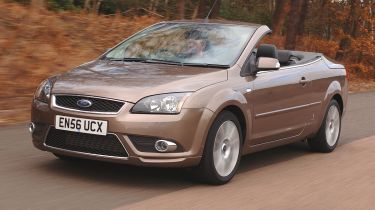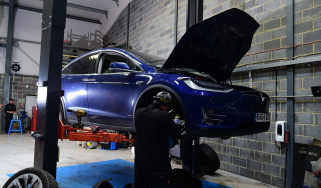Ford Focus CC32.0 TDCi
Does class-leading hatch still lead the field with the roof chopped off?
With styling by top Italian design studio Pininfarina, the Focus Coupé Cabriolet should have a head start in life. But we can
only assume that the firm was having an off day when it penned Ford’s new convertible.
Design is a key part of a drop-top’s appeal – people buy them to make a statement, be looked at and admired, yet we can’t see anyone casting envious glances in the Focus CC’s direction. We’ve criticised the standard hatch for being bland, but the convertible simply looks dumpy and ugly. The rear view is the worst – it’s too long and bulky, the tail-lights look odd and the slab of chrome across the bootlid (apparently intended to give the car a ‘premium feel’) makes the Focus look American. It seems to have been styled on a budget and lacks attention to detail – the folding roof itself suggests as much.
By opting for a two-piece top when its rivals here offer three-part hoods, Ford has made compromises. It can’t fold away into as small a space, so the tail has to be bulky, back seat accommodation suffers, and although there’s a 534-litre load space when the roof is up, when lowered that shrinks by more than half to 248 litres. A good measure of the rear’s poor packaging is that the Eos’s drops by only 175 litres.
At least the Focus’s top is fully automatic and the roofline itself is cohesive. But pity those sitting in the back – limited vertical space means your head is pressed against the rear glass, so you feel rather vulnerable. And those in the front don’t have much to celebrate, either. The layout is lifted straight from the hatchback, and although this ensures excellent ergonomics and logical switchgear, there’s no sense of excitement, and it doesn’t feel as if you’re driving something desirable.
However, all-round visibility is good, thanks in part to the large rear glass, and the controls, including the precise gearchange and positive brakes, operate with a silkiness that’s missing from each of its rivals. But because the windscreen comes back so far, even with the lid lowered, you don’t feel as if you’re driving a drop-top.
The presence of a diesel motor isn’t likely to find favour with everyone, either. But this is no clattery oil-burner. The 2.0 TDCi unit is smooth, refined and far less intrusive than the VW’s motor. Engine rattle is only really detectable when crawling around town – once into second gear, it’s no more intrusive than the TwinTop’s 1.8-litre petrol. Unlike the Eos, turbo pressure builds gradually with no sudden surges, and with a 340Nm overboost function, in-gear pace is strong.
Road manners have always been the Focus’s trump card, and the CC is no exception. Although the Coupé Cabriolet’s frame doesn’t feel as stiff as the Eos’s, it rarely succumbs to scuttle shake, because the Ford’s soft, supple suspension damps out the shocks before they can unsettle the chassis.
There is a fair degree of body roll, but it’s well controlled and the handling is still relatively taut and agile. The Ford’s steering isn’t as weighty as the VW’s, yet the way the Focus tackles corners so effortlessly makes it satisfying to drive.
But there is a downside. While sound levels are low on the whole, with the roof down, the aerial on the header rail whistles at high speed, and there’s excessive wind noise from the A-pillars with the top raised. Nor is the cabin as bluster-free as the Eos’s. But the Focus does undercut its German rival by more than £2,000.
Details
Price: £20,270
Model tested: Ford Focus CC-3 TDCi
Chart position: 3
WHY: We rate the Focus hatch very highly, and if the CC is as good, it’ll put huge pressure on its rivals.
Economy
Pulling only 1,900rpm at 70mph – 100rpm less than the VW and 1,400rpm below the petrol Astra – the Ford’s smooth diesel is very frugal when cruising. Even on our mixed driving route, it didn’t suffer too badly, averaging 39.4mpg.
Residuals
Want proof that the market isn’t convinced about the Focus’s potential? Then take a look at its residuals, which lag six per cent behind the Eos. Although £2,000 more to buy now, in three years, the CC is worth the same as the TwinTop.
Servicing
One of the reasons that Ford opted for a two-piece roof was to improve reliability, thus lessening warranty claims. The CC certainly isn’t too costly to maintain, with three years’ servicing coming in at less than £600.
Tax
Although all three firms expect less than a third of their convertibles will be sold to business users, given the current climate change debate, it’s good to know the Focus only puts out 156g/km of CO2 – 29g/km less than the petrol TwinTop.







